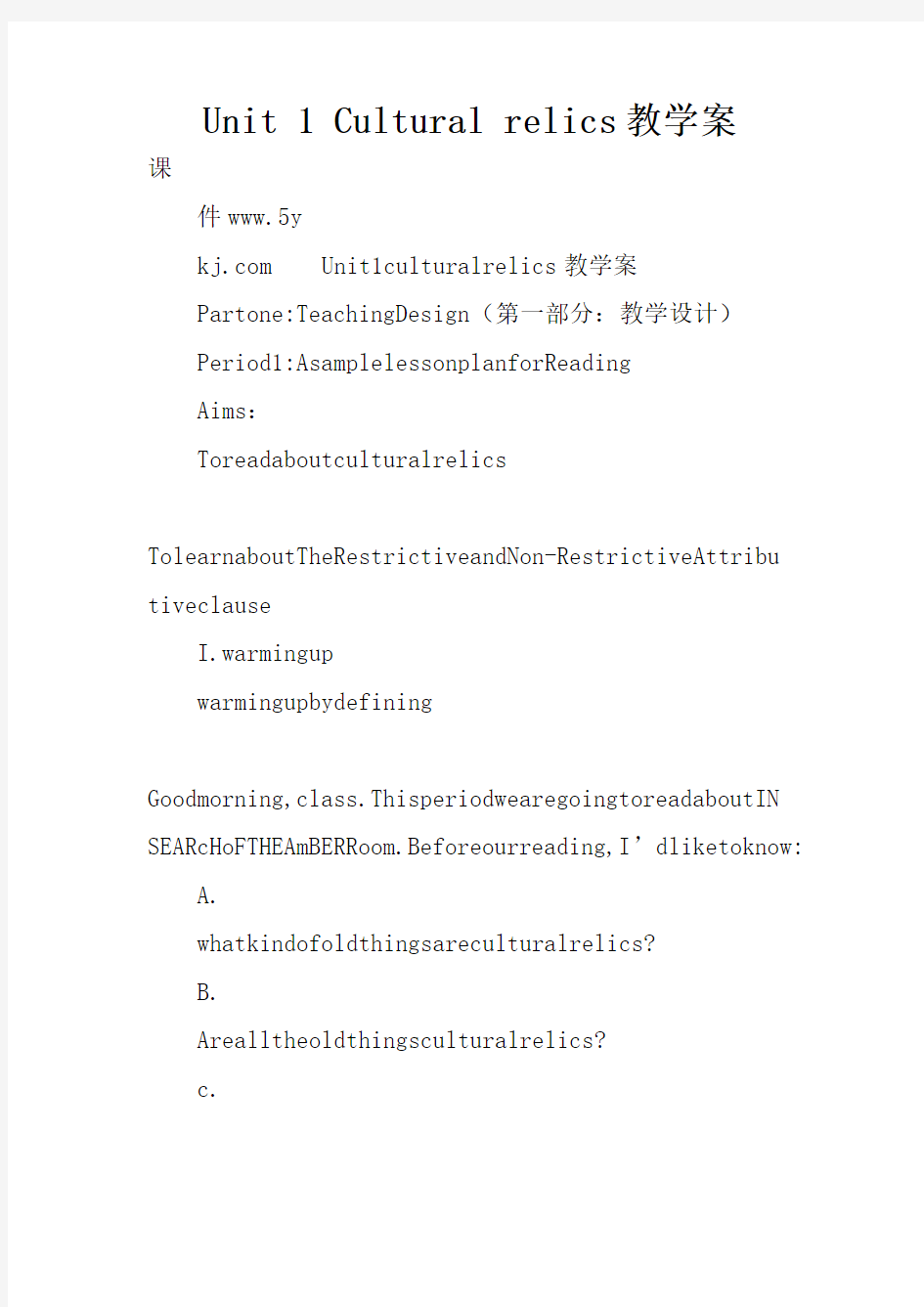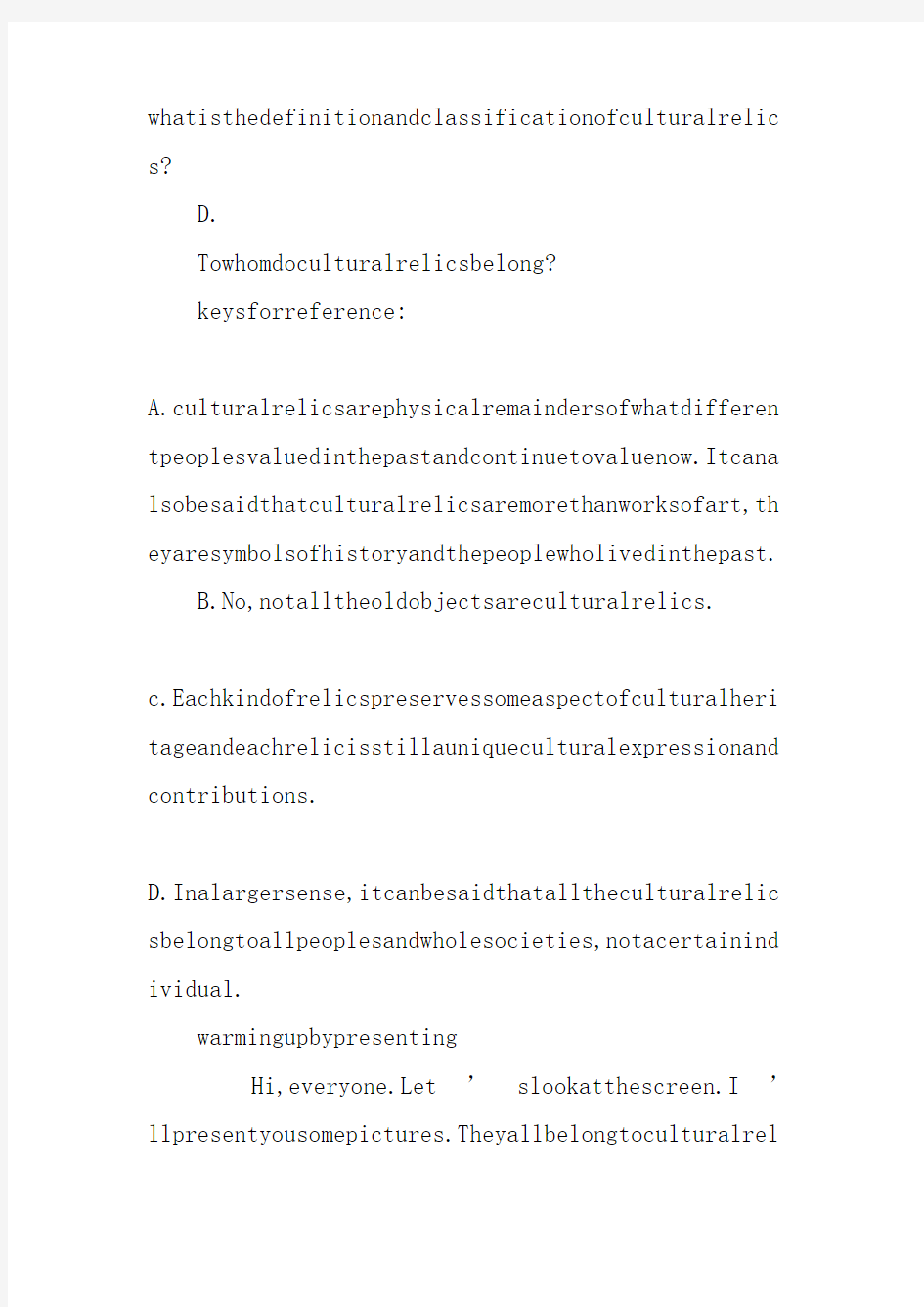

Unit 1 Cultural relics教学案
课
件www.5y
https://www.doczj.com/doc/8614967859.html, Unit1culturalrelics教学案
Partone:TeachingDesign(第一部分:教学设计)
Period1:AsamplelessonplanforReading
Aims:
Toreadaboutculturalrelics
TolearnaboutTheRestrictiveandNon-RestrictiveAttribu tiveclause
I.warmingup
warmingupbydefining
Goodmorning,class.ThisperiodwearegoingtoreadaboutIN SEARcHoFTHEAmBERRoom.Beforeourreading,I’dliketoknow:
A.
whatkindofoldthingsareculturalrelics?
B.
Arealltheoldthingsculturalrelics?
c.
whatisthedefinitionandclassificationofculturalrelic s?
D.
Towhomdoculturalrelicsbelong?
keysforreference:
A.culturalrelicsarephysicalremaindersofwhatdifferen tpeoplesvaluedinthepastandcontinuetovaluenow.Itcana lsobesaidthatculturalrelicsaremorethanworksofart,th eyaresymbolsofhistoryandthepeoplewholivedinthepast.
B.No,notalltheoldobjectsareculturalrelics.
c.Eachkindofrelicspreservessomeaspectofculturalheri tageandeachrelicisstillauniqueculturalexpressionand contributions.
D.Inalargersense,itcanbesaidthatalltheculturalrelic sbelongtoallpeoplesandwholesocieties,notacertainind ividual.
warmingupbypresenting
Hi,everyone.Let’slookatthescreen.I’llpresentyousomepictures.Theyallbelongtoculturalrel
ics.Someofthemareculturalsites.Someofthemarenatural sites.Pleasethinktheseover:
A.
canyounamethemout?
B.
whohavetherighttoconfirmandclassifythem?
keysforreference:
A.Theyareculturalsites:TheGreatwall;TheImperialPala ceofthemingandQingDynastiesinBeijingandShenyang;The mausoleumoftheFirstQinEmperorandtheTerracottawarrio rs;Themogaocave.Thesearenaturalsites:ThejiuZhaiGouV alleyScenicandHistoricInterestArea;TheHuangLongScen icandHistioricInterestArea.Thefollowingareculturala ndnaturalsites:mountTaishan;mountHuangshan;mountwuy i.
B.onlyaninternationalprofessionalorganizationfromUN hastheauthoritytoconfirmandclassifythem.
warmingupbydiscussing
Now,boysandgirls,Imeta “moraldilemma”.ThatmeansImustmakeachoicebetweenth
einterestsofthefamilyandtheinterestsofthesociety.Th ingsarelikethis:myoldgrannyhappenedtofindanancientv aseunderthetreeintheearthofourgarden.It’ssobeautifulandspecial.Now,myfamilyfellintoamoraldi lemma.canyouhelpustomakeadecision:
A:whatshouldwedo?
B:canwekeepitforourselvesorreportittothegovernment?
c:Haveyoucomeacrosssuchasituation—tomakeadifficultchoice?
keys:ABcquestionscanbeansweredinallkindsofways.Thea nswersareflexible.
II.Pre-reading
.Lookingandsaying
workinpairs.Lookatthephotosonthescreen.Allthesereli csarequitebeautiful.Butsomeofthemwerelostandruinedi nhistory,suchasyuanmingyuanandtheAmberRoom.Pleaseguess:
A.
whatkindsofthingscanresultintheirdisappearing?
B.
whydotheycomeintobeingonceagain?
keysforreference:
A.maybewars,naturaldisasters,andtimehavedamagedorde stroyedthem,gettingthemlostandchanged.manyofthemwer eevenstolenandhiddenwhilenobodyknowswho,whereandhow.
B.Peoplegettoknowthese.Iftheserelicscouldnotbefound again,theywouldberebuiltbypeople.
2.Explainingandsharing
workingroupsoffour.Tellyourgroupmates:
A.
whatdoyouknowaboutthesubstanceof“amber”?
B.
whatdoyouknowabouttheculturalrelics “theAmberRoom”?
keysforreference:
Iamfromgroup2.Fromtheknowledgewegotfrombiologyandch emistry,weknow“amber”isasemi-preciousstoneusedinjewelryandartworld.Amber
isreallythefossilformofresinfromtrees.Ithasgotitssh apeafteraprocessthathastakenmillionsofyearstocomple te.Treesinveryancientforestsproducedthisresin,which slowlydroppedfromtreesandwasburied.Treesuseresintop rotectthemselvesfromdiseaseandharmcausedbyinsectsan dfungi.
Iamfromgroup6.Fromtheinformationofhistorylegendsand newsreports,weknowtheAmberRoomisaroombuiltbylotsofa mbers.ItwasagiftgiventoPetertheGreat,thekingofRussi a,bythekingofPrussia,FrederickwilliamI.Itwasgiventh enamebecausealmostthousandtonsofnaturalamberswereus edtomakeit.Butduringthesecondworldwarin1941,theNazi GermanarmysecretlystoletheAmberRoomandsentboxesofth eAmberRoomonatraintoaGermancity.Afterthat,whatreall yhappenedtotheAmberRoomremainsamystery.
III.Reading
.Readingaloudtotherecording
NowpleaselistenandreadaloudtotherecordingofthetextI NSEARcHoFTHEAmBERRoom.Payattentiontothepronunciatio nofeachwordandthepauseswithineachsentence.Iwillplay
thetapetwiceandyoushallreadaloudtwice,too.
2.Skimmingandidentifyingthegeneralideaofeachparagra ph
Nowpleaseskimthetexttogetthekeywordsandgeneralideao feachparagraph.
stparagraph
theintroductionabouttheAmberRoom:design,colour,shap e,material
2ndparagraph
thepresenttotheczar:apartofwinterpalaceinSt.Petersb urg,areceptionhallforimportantvisitor
3rdParagraph
therelocatingoftheAmberRoomincatherirⅡtimes:movedintoSummerPalace,moreaddedtoitsdesign 4thParagraph
themissingoftheAmberRoom:thetwocountrieswereatwar,N aziGermanarmystoletheAmberRoom,27woodenboxesweretra
inedtoaGermancity,Nobodyknewitfromthenon
5thParagraph
therebuildingoftheAmberRoom:anewonebutthesameastheo ldbuiltbythetwocountries,forcelebratingthe300thbirt hdayofPeterburg
3.Scanningandanalyzingthecharacteristicsofthetext.
Sinceyouhavegottoknowthegeneralideasofeachparagraph ,canyoutellmethecharacteristicsofthepassage,suchas, thetypeofwriting,thewayofnarrating,andthetense?
keysforreference:
Thispieceofpassageisanarrativeproseornon-fictionart iclewritteninanarratingstyle.IttellsthehistoryofAmb erRoomintheorderoftimesothatwecanclearlylearnaboutw hathappenedtoit.Thetenseusedinthetextispasttense.
4.Readingandunderstanding
Nextyouaretoreadandunderlinealltheusefulexpressions orcollocationsinthepassage.copythemtoyournotebookaf
terclassashomework.
collocationsfromINSEARcHoFTHEAmBERRoom
lookinto…,beusedto…,makethedesignfortheroom,infac t,asagiftof…,addmoredetailsto…,remove…fromthesearchfor…,belongto…,feelashardasstone,the fancystyle,bemadefor…,inreturn,oneofthegreatwonder s,artobjects,lookmuchlike…,givethename,bemadeintoa nyshape,bemadewithgoldandjewels,bemadetobeagift,ser veas…,atwar,remainamystery,bereadyfor…
5.Readingandtransferringinformation
Readthetextagaintocompletethetable,whichlistsallthe numbersinthetext.
NUmBER
mEANING
716
FredericwilliamgavetheAmberRoomtoPetertheGreatasagi ft.
770
catherineⅡ
hadcompletedtheaddingtotheAmberRoominthisyear.
941
TheNaziGermanarmystoletheAmberRoominthisyear.
XX
TherebuildingoftheAmberRoomwascompletedinthisyear.
7000Tons
Thetotalweightoftheambersusedtomaketheroom.
55
ThenumberofsoldiersgiventothekingofRussiainreturn.
600
ThenumberofthecandleslightingtheAmberRoom.
2
Thetwocountries:GermanandRussia.
2
IntwodaystheAmberRoomwasremovedtoaGermancity.
00,000
TheAmberRoomwasdismantledinto100,000pieces
27
27woodenboxeswereusedtocontainthepiecesofAmberRoom.
300th
ThenewlyrebuiltAmberRoomwasreadyforthe300thbirthday ofStPeterburgcity
6.Readingandlearning
Readthetextandlearnmoreaboutthefollowingpropernouns .youcansurfonthewebsiteafterclass:
Namesofpeople
Namesofplaces
FrederickⅠ
Prussia
FrederickwilliamⅠ
St.Peterburg
PetertheGreat
konigsberg
catherineⅡ
winterPalace
SummerPalace
Ⅳclosingdown
closingdownbydoingexercises
ToendthelessonyouaretodothecomprehendingexercisesNo .1andNo.2.
closingdownbyhavingadiscussion
A.
canyouimaginethefateoftheAmberRoom?whatisit?
B.
DoyouthinkifitisworthwhiletoreproducetheAmberRoom?w hy?
keysforreference:
A.IhavenoideaaboutthefateoftheAmberRoom.Becauseanyt hingcanhappentoit.maybeitwasdestroyedatwarinthefigh tingfire.yousee,amberscanbemeltedeasily.maybeitwask eptsecretlybysomebodywhohaddiedwithouttellingabouti ttoanyoneelse.Somaybeitislyingsomewherequietly.
B.IthinkitisworthwhiletoreproducetheAmberRoom.Becau seitrepresentsthecultureandaperiodofhistoryinSt.Pet ersburg.Itisatraceandfeaturesurvivingfromapastagean dservingtoremindpeopleofalosttime.
closingdownbyretellingthestoryoftheAmberRoom
well,allofushavelearnedthehistoryoftheAmberRoom.Let’srecallsomekeywordsandexpressionsontheboard.youaret oretellthestoryoftheAmberRoom:
colour
Style
Shape
owner
present
movetowinterpalace
addto
moredetails
removetopieces
putontrains
remainamystery
300thbirthday
Period2:AlessonplanforLearningaboutLanguage
Aims:
Tolearnabouttherestrictiveandnon-restrictiveattribu tiveclause
Todiscoversomeusefulwordsandexpressions
Todiscoversomeusefulstructures
Procedures:
I.warmingup
warmingupbydiscoveringusefulwordsandexpressions
Pleaseturntopage3.Doexercises1,2,3and4first.Pleasec heckyouranswersagainstyourclassmates’.
warmingupbyexplaining
Now,class,sinceyou’vereadthepassage,couldyouexplaintomehowtousethephra se“belongto”?Theword“to”hereisapreposition,indicatingthepossession,andisalw aysfollowedbynounsorpronoun.LookatEx3.Theprepositio n“at”indicatesastate,conditionorcontinuousactivity.Sowec anreplacethemorexpressthembyusingapresent-continuou stense.
II.LearningaboutAttributiveclause
.whatisanadjectiveclause?
Anadjectiveclauseisadependentclausewhichtakesthepla ceofanadjectiveinanotherclauseorphrase.Likeanadject
ive,anadjectiveclausemodifiesanounorpronoun,answeri ngquestionslike“which?”or“whatkindof?”considerthefollowingexamples:
Adjective
theredcoat
Adjectiveclause
thecoatwhichIboughtyesterday
Liketheword“red”inthefirstexample,thedependentclause “whichIboughtyesterday”inthesecondexamplemodifiesthenoun“coat.”Notethatanadjectiveclauseusuallycomesafterwhatitmod ifies,whileanadjectiveusuallycomesbefore.
Informalwriting,anadjectiveclausebeginswiththerelat ivepronouns“who,”“that,”or“which.”Ininformalwritingorspeech,youmayleaveouttherelative pronounwhenitisnotthesubjectoftheadjectiveclause,bu tyoushouldusuallyincludetherelativepronouninformal, academicwriting:
informal
Thebookspeoplereadweremainlyreligious.
formal
Thebooksthatpeoplereadweremainlyreligious.
informal
Somefirefightersnevermeetthepeopletheysave.
formal
Somefirefightersnevermeetthepeoplewhomtheysave.
Herearesomemoreexamplesofadjectiveclauses:
themeatwhichtheyatewastainted
Thisclausemodifiesthenoun“meat”andanswersthequestion“whichmeat?”.
They’retalkingaboutthemoviewhichmadehimcry
Thisclausemodifiesthenoun“movie”andanswersthequestion“whichmovie?”.
Theyaresearchingforthestudentwhoborrowedthebook Theclausemodifiesthepronoun“student”andanswersthequestion“whichstudent?”.
DidItellyouabouttheauthorwhomImet?
Theclausemodifiesthenoun“author”andanswersthequestion“whichauthor?”.
2.Restrictive&nonrestrictiveclauses
Dothefollowingpairsofsentencesmeanthesamething?
amyuncle,wholivesinLondon,isveryrich.
2bmyunclewholivesinLondonisveryrich.
2aThepolicies,whichwereunpopular,wererejectedbythev oters.
2bThepolicieswhichwereunpopularwererejectedbythevot ers.
3amyniece,whosehusbandisoutofwork,willinheritthehou se,whichIhavealwaystreasured.
3bmyniecewhosehusbandisoutofworkwillinheritthehouse whichIhavealwaystreasured.
Thefirstsentenceineachpairhasanon-restrictiveclause withintwocommas,andthesecondhasarestrictiveclause.
Anon-restrictiveclausesimplyaddsmoreinformationinto thesentenceanddoesnotaffectthemeaningofthemainclaus e:
itisthereforebracketedoffwithcommas.
conversely,arestrictiveclausedefinesitsreferentinth emainclausemorespecificallyandcontributessignifican tlytothemeaningofthesentence.
ThusitisthatparticularunclewholivesinLondonwhoisref erredto.
In2a,allpolicieswereunpopularandallwererejected,whe reasin2bonlythepoliciesthatwereunpopularwererejecte d.
Notethatinrestrictiveclausesthenon-humanrelativepro nouniseither‘that’or ‘which’,whereasforhumanreferentstherelativepronou ncanbeeither‘who/m’or‘that’.
3.AtestonFoRmALADjEcTIVEcLAUSES
Directions:https://www.doczj.com/doc/8614967859.html,eformalwrittenEngl ish.
Useasanadjectiveclause.Punctuatecarefully.
)Anantecedentisaword.Apronounreferstothisword.
Anantecedent____
2)Thebluewhaleisconsideredthelargestanimalthathasev erlived.Itcangrowto100feetand150tons.
Thebluewhale____
3)Theplanewasmetbyacrowdof300.Someofthemhadbeenwait ingformorethan4hours.
Theplane____
4)Inthispaper,Iwilldescribethebasicprocess.Rawcotto nbecomescottonthreadbythisprocess.
Inthispaper,Iwilldescribe____
5)Theresearchersaredoingcasestudiesofpeopletodeterm inetheimportanceofheredityinhealthandlongevity.Thes epeople’sfamilieshaveahistoryofhighbloodpressureandheartdis ease.
Theresearchersaredoingcasestudies____
6)Attheendofthismonth,scientistsattheinstitutewillc onducttheirAIDSresearch.Theresultsofthisresearchwil
lbepublishedwithin6months.
Attheendofthismonth,scientists____
7)Accordingtomanyeducationofficials,‘mathphobia’isawidespreadproblem.Asolutiontothisproblemmustandc anbefound.
Accordingtomanyeducationofficials,‘mathphobia’____
8)Theartmuseumhopestohireanewadministrator.
Underthisperson’sdirectionitwillbeabletopurchasesignificantpiecesof art.
Theartmuseum____
9)Thegiantanteaterlicksupantsforitsdinner.
Itstongueislongerthan30centimeters.
Thegiantanteater____
0)Theanteater’stongueissticky.
Itcangoinandoutofitsmouth160timesaminute.
Theanteater’stongue____
III.closingdownbytakingaquiz
QuizonAttributiveclause Selectoneanswerfromthechoicesprovidedaftereachsente
Unit 1 Art Teaching plan I. 单元教学目标: 1. Talk about art and galleries 2. Talk about likes and preferences 3. Learn words in families 4. Use the subjunctive mood 5.Write a short passage about art II. 目标语言 1.功能句式Talk about likes and preference: I’d prefer…/ I’d rather…/ I’d like…/ which would you prefer…./ I really prefer…/ would you rather…/ would you like…or… 2. 词汇abstract, sculpture, gallery, consequently, belief, consequent, convince, shadow, ridiculous, controversial, nowadays, attempt, predict, aggressive , scholar… 3. 语法: the subjunctive mood If I were you…./ I wish I could… 4. 重点句子1.)There are so many different styles of western art it would be impossible to describe all of them in a short text. 2.)People became focused more on human and less on religion. 3.)If the rules of perspective had not been discovered, people would not have been able to paint such realistic pictures. 4.)At the time they were created, the impressionists’painting were controversial but today they are accepted as the beginning of what we now call “modern art”. 5.)It is amazing that so many great works of art from late-19th century to 21st century could be contained in the same museum. III. 教材分析本单元以ART 为主题,主要介绍了西方绘画历史,描写了曼哈顿最好的艺术长廊。帮助学生了解更多的有关美术的背景知识,分析中西艺术史上各大流派的特点,指出其代表性的画家和作品,并对中西方的绘画艺术进行比较。 1.Warming up 部分要求学生运用相关目标语言对自己喜欢的艺术形式和流派展开讨论,并说明喜欢的原因。 2.Pre-reading 让学生有关画展或书中的艺术作品以及西方不同时期的著名画家。3.Reading 介绍了西方绘画历史,不同的艺术流派,艺术特点及其代表性画家和作品。4.Using language 是由reading, listening, discussing and writing 四部分组成,要求学生在了解艺术长廊相关知识的基础上,为当地举办的一场画展提出合理化的建议。 IV.课型设计与课时安排 1st period learn the new words and expressions 2nd period reading 3rd period language points 4th period using language 5th period listening and talking 6th period grammar 7th period speaking and writing 8th period revision and consolidation 分课时教案
Unit 1 How do you study for a test? 第一课时Section A 1a—2d 课型:听说课 学习目标: 1、我会读P1-2的单词,理解并会用以下的单词:textbook,conversation, aloud,pronunciation,sentence,patient 2、我能运用以下句子谈论学习英语的方法。(难点) 1)---How do you study for a test?---I study by working with a group. 2)---Do you have a conversations with friends?---Yes , I do./No, I don’t. 3)---Have you study with a group?---Yes,I have./No,I don’t. 3、我通过了解正确的学习方法我提高学习效率,从而提高我的学习成绩。 Learning Process学习过程 Steap I目标导航,自主学习(课前完成) 读一读,记一记P1-2的单词,默读并理解1c,2c,2d的对话,根据中文写出单词或短语。(一)单词 1.教科书;课本 2. 交谈;谈话 3.大声地;出声地 4.句子 5.有耐心的;病人 (二)短语 1. 与朋友一起学习___________________ 2. 制作单词卡___________________ 3. 向老师求助___________________ 4. 听磁带___________________ 5. 读课本___________________ 6. 向某人要某物___________________ 7. 为考试而准备___________________ 8. 与某人交谈___________________ 9. 大声朗读___________________ 10. 练习(做)某事___________________ 11 .口语表达能力___________________ 12. 英语口语___________________ 13. 太......而不能___________________ 14. 完成做某事___________________ 15.不得不做___________________ 16. 作报告___________________ 17. 抓住主要意思___________________ 18. 逐字___________________ 19. 词组___________________ 20. 对某人有耐心___________________ StepⅡ合作探究,展示提升(20分钟) Task 1、短语过关:对子就关于英语学习方法的短语中英互译 Task 2、听力过关:按课本完成1b,2a,2b的听力。 Task 3、编写对话:你可以借鉴1c,2c聊聊英语的学习方法 Task 4、朗读2d,画出对话中提到的学习方法,并回答下列问题。 1. How does Jack? Why? __________________________________________________ 2. What suggestions does Annie give to Jack?___________________________________ Task 5: 质疑互究: 1.by的几种用法 (1)--How do you study for a test? --By ____________________(小组合作学习) (2). Annie went to Beijing __________________ (乘火车) yesterday. (3). His grandfather made a living _____________________ (靠卖水果) in the past. (4). The scientists have to arrive at the village _____________________ (八月以前). (5). Allen goes ________________________(经过邮局) on his way to school every morning.
公开课教学简案 新课标初中英语教学简案(译林牛津英语) 课题:9A Unit5 Welcome to the unit & Vocabulary 执教者:王宁
【设计思想】: 新课标要求:英语教学应充分体现“以人为本”的教学思想,调动学生的积极性,学以致用,培养学生的语言运用能力。 本课题是牛津英语9A第五单元第一课时,本着让学生认识并学会使用各种类型的电影词汇,了解电影拍摄的有关术语。本节课紧紧围绕这一要求,以“film”为主线,创设问题情境,采取灵活多样、生动形象的活动方式,如:抢答、对话、小组讨论等一系列的活动,促使学生参与学习,合作学习,探究学习,尽可能让学生在活动中感悟生活体验,将语言与生活实际紧密相联,培养学生的语言交际能力。 【教学目标】: 1.Knowledge Objectives (1)cartoon, action film, horror film, romantic film, science fiction film, western (2)Action! Good take! Stand by! Take two! (3)You should be more realistic. 2.Ability Objectives (1)To understand vocabulary relating to films and being a director. (2)To talk about different jobs in the film industry. (3)To use vocabulary to talk about different types of films 3.Emotion Objectives (1)Know about favourite films. (2)Name the types of films after learning this unit 【教学重点】 (1) Grasp the names of different types of films (2) Make a dialogue:Being a director 【教学难点】: (1)Different jobs in the film industry. (2)Name the types of films after learning this unit. 【教学手段】: Multi-media computer,blackboard
高中英语Unit1Art 试题 2019.09 1,--- I’ll ask our physics teacher to explain Newton’s Second Law of Motion she taught us yesterday. ----That’s just _______ most of the students have doubt. A. what B. why C. how D. where 2,I remember _______ this used to be a very small village. A. when B.how C. where D. what 3,Since she left home, I have been worried about her and _____ well at all. A. was sleeping B. wasn’t sleeping C. haven’t been sleeping D. have been sleeping 4,Quite a lot of people _______ the tradition of making pancakes on Shrove Tuesday. A. catch up B. date back C. blow up D. keep up 5,All children in the United States have to receive an education, but not all children go to school. A number of parents 1 not to send their children to school. Such children are known 2 “home-schoolers”. Some parents prefer teaching their children at home 3 they do not believe schools teach the correct religious
《Module 1 Unit 1 I’m Sam》教学设计 知识与技能: 1、基本能听懂会说:“Hello, Hi, Goodbye, Bye-bye” 2、学会运用句型“I’m…”进行自我介绍。 3、不与陌生人接除、交谈,注意自我保护。 过程与方法: 通过模仿教师发音、口型和观看多媒体教学课件,并经过师生、生生之间的对话基本能听懂“Hello, Hi, Goodbye, Bye-bye”,能运用“I’m…”进行自我介绍,达到初步认识本册书中主要人物Sam、Amy、Lingling 、Daming的目的。并注意Sam和Amy的正确发音。 情感态度与价值观:培养学生学习英语的兴趣,初步了解东西方文化差异。 教学方法设计:主要采用情境教学法、交际法、游戏教学法、动作教学法等。教学重难点:句型“I’m…”的运用。 教学准备:多媒体资源包,单词卡片,小贴画,人物头饰 课时安排:一课时 教学过程设计: 一、Free talk . (1)播放英文歌:Happy birthday to you! (2)使用课前收集的一些常用英文单词或缩略语如:DVD,CD,CCTV,OK等让学生了解一些身边的英语,同时也请同学们说一说他们所知道或听到的英语。 二、New teaching.
1、学习打招呼: Hello Hi. Goodbye Bye-bye 教师首先以自然的方式配以恰当的手势动作和不同的语调来向学生问好Hello , Hi。同时也引导学生向教师说Hello , Hi 。谈完话分手时用Good bye或者Bye-bye道别。然后让学生相互间用Hello, Hi 练习问好,用Good bye或者Bye-bye道别。(Hello与Hi 的区别与联系:一般在正式的场合用Hello 为引起对方的注意而问好;而Hi一般是用于对自己亲密的人打招呼)操练时注意避免重复使用。 2、传声筒游戏。游戏规则:将全班分成四组,教师分别悄悄告诉每组第一名学生一句问候语:Hello、Hi、Good bye、Bye-bye,四组游戏同时开始,第一名同学将问候语悄声传给第二名同学……,依次下去,哪一组先传完问候语,哪一组就是获胜组并给予小红花奖励。(交换每组的问候语再玩3次,以加深学生对语言点的熟练程度和准确把握程度。) 3、学习:I’m… (1)教师胸前佩带英文的名字卡片进行自我介绍:Hello, I’ m Wangxingjian ,借助手势让学生理解句子含义。 (2)邀请几位同学到讲台上来,分别戴上他们喜欢的人物头饰并自我介绍说Hello ,I’m …然后请同学作真实的自我介绍。 4、认识人物:Sam, Amy, Lingling , Daming
Unit 4 Do you like pears? 一、创设情境 师:Hello, boys and girls, nice to meet you. 生:Hello, nice to meet you, too. 师:How are you? 生:Fine,thank you, and you? 师:Let’s sing a song, Ok? 生:OK! (播放歌曲) 师:Do you remember this song? 生:Yes. 师:So many colours. What’s else have these colours? 生:水果、、、、、、 师:Wow, you are so great. The fruits have many colours. Today we are going to learn a new lesson.(板书:Do you like pears? ) 二、新授 1、师:Today, I bring some gifts for you. Before I give them to you, you should guess what they are. OK? 生:OK! (出示课件苹果猜谜) 师:guess,what it is?
生:苹果 师:Let’s check it. Yes, it is apple. Now, read after me, apple, A-P-P-L-E(分声调读,让学生读)(板书)拿出苹果实物。 师:I like apples, do you like apples? (出示课件Do you like…)(板书) 师:Do you like… Yes, .No 师:apple , apples 喜羊羊say “Yes, I do.” The other say:“No, I don’t.”Do you like apples? (挑学生回答) (出示第二张谜语) 师:Guess,what it is ? 生:橘子 师:How to speak it in English? Let’s check it. You are right. Now, read…… 同上 2、Let’s chant 师:So many fruits. Let’s chant. (出示课件,让学生跟着唱) 三、巩固 1、画一画 师:I like playing game, do you like playing game? Now, it is game time. The game is “I say, you do”. Please take out your pencil and paper. Drawing a picture of your favourite fruit. 生:让学生自己画。
Unit 1 Hello 第一课时 一、教学内容 PEP三年级上册Unit 1 Hello! A Let's talk, Let's play, Let's sing 二、教学目标 1.能听懂,会说Hello. Hi. Goodbye. Bye-bye. I'm... 2.通过见面打招呼,自我介绍以及道别等情景,让学生在模仿、学习、表演的基础上逐步达到自然与真实运用的目的。 三、教学重点和难点 1. 教学重点:Hello/Hi. I'm... 2. 教学难点:元音字母I在单词I、Bye、White 中的发音。 五、教学过程 1. 热身(Warm up) T: Hi, boys and girls. Look, what's this? Ss: CD/VCD/DVD. T: Cool. You're great!(做动作:竖大拇指表扬学生。)你们知道的英语知识真不少!Yes, it's a VCD. It's Magic English. (展示给学生看) T: Do you like cartoon(动画片)? Ss: Yes. T: Let's watch it, then tell us what can you see?What can you hear? T: What can you see, boy?(Ask one student to answer.)
S1: 我看见有小飞侠、米老鼠、唐老鸭、阿拉丁…… S2: 我看见有Snow White和七个小矮人…… T: What can you hear, girl? S3: 我听见米老鼠说:“Hello! I'm Mickey...” S4: 我听见说:“Hello! Nice to meet you! ...” 2. 新课展示(Presentation) ⑴ T: Today, Miss Li will make some friends. Do you want to be my friends? Ss: Yes. (The teacher walks to a student.) T: Hello, I'm Cami (My English name). What's your name?(教师将手伸向该下学生,做出请他回答的手势。) S1: Hello! I'm Wang Jiaqi. T: Hello, Wang Jiaqi.(教师友好地与该学生握手) S1: Hello, Cami. (对该学生进行奖励,将小贴画贴在该同学身上。教师也可以和她拥抱一下表示友好。) T: I'm...(提醒并纠正I'm的发音,应为/aim/不能读成/em/)Then the teacher walks to other students and greet them in the same way. (2) 用介绍朋友的方式出示这节课中的主要人物,让学生熟悉他们的相貌和名字。
《What’s the matter?》教学设计 Section A 1 (1a – 2c) 一、教学目标 知识与能力:学习掌握有关身体的词汇以及有关疾病的词汇,并学会描述身体的不适和提出建议。听懂本课学习活动中的问题及回答,能在本课的任务型活动中进行简单的交流,能正确朗读本的对和句型,能写出本课的单词和句型。 过程与方法:作为教学的引导者,我遵循新课程“学生是学习的主人,一切的教学活动设计以学生为本”的教学理念,坚持“为学生的发展,必须培养学生的自主性、能动性、独立性和创造性”的教学原则。课堂教学中利用图片,单词卡片等直观的教学手段,通过任务型教学法,游戏教学法,情景教学法等教学法引导学生学习,使枯燥的单词教学变得生动有趣,激活课堂,最终达到预期的教学目标。 情感态度与价值观:通过描述自己的身体的不适提出建议,表达自己的看法,使学生在人际交往中学会关心别人,增进情谊。用恰当的方式表达自己的看法,增进人际交往中学会关心别人的能力,了解英美国家询问和表达身体不适的习惯,培养世界意识。 二、教材分析及教学重难点 教材分析:本节课的主要内容是新目标英语八年级上册第2单元第一课时,教材是以What’s the matter ?为中心话题,描述身体不适和提出建议展开,学习和运用What’s the matter 和“What should …do?”让学生学会描述身体的不适和提出建议,本课教材内容与学生的实际生活密切相关,易于引出学生运用简单的英语进行交际和交流,在学习活动中,学生通过交换对身体不适的描述及建议,促进学生之间和师生之间的情感交流,增进情谊。 学情分析:八年级学生有了一定的语言基础,再加上本课内容为询问人的身体健康方面的问题,与学生的生活密切相关,更容易激发同学们的学习兴趣和参与度。 教学重点:本节课主要学习身体部位的单词和一些疾病的词汇,以及身体不适的表达及建议。第一课时主要学习的内容是学习有关身体部位的单词,学习“What’s the matter ?”和“What should …do?”句型。 教学难点:身体不适的表达及建议,掌握情态动词should \shouldn’t. 的用法,学习have的用法 三、教学策略 语音教学让学生进行模仿操练;词汇教学──采取情景介绍或演示对比的方式进行教学,让学生在情境中操练、理解含义,并学会运用;口语教学采取pair work 问答式的口语交际活动或游戏等小组活动互相操练;听力教学采取图文配对和对话选择的方式;写作教学以填词、回答问题、写简单的短文为主;语法教学——总结规律、抓住特征、模仿操练。
教学设计与教案的区别 教学设计——教师运用系统方法,对学习行为目标、学生学习特征分析,学生学情分析、学习环境分析,、选择策略手段、制定教学流程、评价教学效果、以达到课堂最优化的编制教学预案的过程。 教案——堂教学的实施方案,即教师根据所授课程的特点,结合学生的具体情况,选择最合适的表达方法和顺序,以保证学生有效地学习,教案一般有表格式、描述式、画图式和画图加表格式课堂实录式,普通文本式等,主要体现怎么设计。 一、教案和教学设计的相同之处 1、两者的教学目的和教学目标的确定,都是根据教学对象和教学内容而制定。 2、计划性:它们都是根据一堂课涉及的所有因素而设计的教学内容。为了保证教学目的的完成,一般老师都对教材进行过研究和钻研。 3、程序相同:对教材的钻研,确定教学目的,明确教学内容、教学的重点、难点,选定教学过程的方式、课型、方法、教具、时间等。 二、区别 1、教案和教学设计上存在不同:教案是老师教什么,学生学什么,学生根据老师安排的教学内容进行学习、思考、模仿等过程。而教学设计是根据学生的学情、智力等水平出发,学生学什么,老师教什么。所以两者的设计上刚好相反。教案一般多半以教材、教参为主,而教学设计把教学本身作为一个整体系统来考虑,运用系统方法来设计、开发、运行、管理,即把课堂教学系统作为一个整体来进行设计实施和评价,使之成为具有最优,不但使学生学会所要求的知识,而且学生在学习过程中思维得到锻炼、情感目标和价值观得到丰富。课堂教学设计与教案的层次关系是不完全对等的 2、指导思想不同教案是以课堂教师、教材为中心的传统教学思想的体现,它的核心目的就是教师怎样讲好教学内容,使学生要掌握的所学知识,很重视对学生进行封闭式的知识传授和技能训练,强调教师的主导地位,却常常忽略了学生的主体地位,这样导致的后果是便于学生的知识增长,但是他们的社会适应能力不足,理论联系实际能力缺乏,很多学生缺乏创造力、思维不活跃、模仿能力强,不能体现现在社会的人才培养目标;课堂教学设计不仅重视教师的教,更重视学
3A Unit1 Hello 第一课时 一、教学目标: 1.学生能听懂、会说、会读、会运用句型:Hi/ Hello, I’m …/ Good morning.。 2.学生能认识主要的人物:Miss Li,Su Hai,Liu Tao,Mike, Wang Bing。 3.学生能够在不同的情境下和周围的人打招呼。 二、教学重点: 1.学生能听懂、会说、会读、会运用句型:Hi/ Hello, I’m …/ Good morning.。 2.学生能认识主要的人物:Miss Li,Su Hai,Liu Tao,Mike, Wang Bing。 3.初步会用英语表达自己的名字。 三、教学难点: 1.学生能听懂、会说、会读、会运用句型:Hi/ Hello, I’m …/ Good morning./Good afternoon.。 2.初步会用英语表达自己的名字。 3.学生能够在不同的情境下和周围的人打招呼。 四、教学准备: 挂图,卡片,PPT 五、教学过程 Step 1 Greeting. 1.在上课前,老师先放本单元的Song Time里 面的歌来吸引学生的注意力。让学生下课也沉浸在英语的氛围中。 2.在新授课前,教师先用英语和学生打招呼, 引入本单元的新授学习 T:Hello, I’m (Miss/ Mr) …I’m your English Teacher. Let’s learn English. Ok? (举起英语书,不要求学生能全部听懂,但是要知道接下来老师要的是关于这本英语书的内容。 Ss: OK. (如果学生不会回答,就适当提示) T:Now class begins.Hello,class. (老师朝学生挥手,让学生初步意识到老师在和他们打招呼) Ss:Hello. (如果不是回答的很整齐老师也不用太在意) Step 2 Presentation 1.出示单词卡片:Hello,并读 a.开火车读(read one by one) T: Can you read Hello? 如果学生听不懂,老师就在学生的耳边轻轻地提醒他说hello。 b.Read four by four
适用学科 高中英语 适用区域 人教新课标版
适用年级
高二
课时时长(分钟) 2 课时
1 单词学习及辨析
知识点 2 虚拟语气
3 开放作文练习
教学目标
1. 掌握本单元重点词汇的基本含义与用法; 2. 锻炼提升写作能力。
教学重点
1. 重点的词汇与句型; 2. 书面表达的书写思路。
教学难点 如何准确地运用重要词汇和句型进行表达
教学过程
一、导入
教学建议:导入有很多种方法,一般控制在十分钟左右为宜,可以采用各种形式,比如: 1、直接导入法。 2、复习以往知识:可以从已学、已知的入手,与今天的教学进行对比。 3、课前小测:可以针对学生学校里近期讲授的内容进行出题(以简单题和中档题为主,以 10 分钟左右为宜)进行测验,也可以针对基础知识进行复习提问,检查学生学校所学内容 的掌握程度,进而展开教学。 4、以近年来发生的重大事件为题导入。既考查了学生从社会生活中获取信息的能力,又激 发了学生的学习兴趣,让学生马上进入学习状态等。
以上的导入方法只是建议,大家选择其中一种或两种进行交叉使用即可。
复习:上节课作业订正。
二、知识讲解
知识点 1 重点单词
1) faith n.信任;信心;信念 have faith in 对……有信心;信仰…… lose faith in 对……失去信心 be faithful to 忠实于某人 She has placed a great deal of faith in him. 她对他极其信任。 People have lost faith in the British Parliament. 人们已经对英国议会失去了信任。 夯实基础 (1)The older Tibetans have said they_______________________________ (对……有信心) the young generation. (2)Mary _______________________________(对……忠诚)her husband. 【答案】:1have faith in 2 is faithful to 2) consequently adv.因此;所以 (in consequence=as a consequence=as a result 因此;所以 in consequence of=as a consequence of=as a result of 由于 As a consequence,I decide to exchange it for something that I really need at present. 因此,我决定用它来换取目前真正需要的东西。 As a consequence,the number of polar bears is becoming smaller and smaller. 结果北极熊的数量变得越来越少。 夯实基础
教学设计 Unit1 My name’s Gina Period1 (1a-2d) 开阳县第二中学:况培敏 一、教材依据 人民教育出版社七年级英语(上册)第一单元Section A(1a-2d). 二、教材分析 本单元围绕“结交新朋友”这一主题,让学生学会打招呼和介绍自己,询问他人姓名的基本句型:“What is your/his/her name? My/His/Her name is...”通过学习区分“first/last name”.了解有关姓名的文化知识,通过查询电话号码“What’s Your/her/his phone number?”,及其回答,学习数字1--9的英文表述方式,同时也进一步促进学生之间的互相了解。通过以上几个方面的学习,使学生在轻松,愉快的学习氛围中熟识新伙伴。本单元与第二单元衔接紧密,由课堂内的打招呼,自我介绍到课外,校外互相了解,由特殊疑问的学习,使学生将书本知识运用到实际生活中。 三、学情分析 单元的主题是熟识新伙伴,同时引导学生采用Practicing, Listening for speci -fic information和Role playing的学习策略,学习一些新词汇,掌握一些重点句型,在小组合作学习的过程中,进一步促进学生之间的相互了解。很多同学可能对英语已经产生了浓厚的兴趣,所以在教授句型时,一定要尽量多安排活动,让他们大胆去说,去练,去模仿,有必要时采用游戏的方式,增加他们学习英语的兴趣,为以后的学习打下好的基础。 四、教学目标 (一)知识目标 1.一般现在时be的用法。 2.形容词性物主代词my,your,his,her及人称代词I,he,she. 3.省略式What’s =What is I’m=I am My name’s =My name is he’s =he is she’s =she is 4.中英文名字的区别。 (二)能力目标 1、培养学生的听、说、读、写的能力。 2、培养学生的与同伴合作的能力。 (三)过程与方法: 采用自主学习、小组合作探究学习策略,利用教学图片、幻灯片等来展开课堂教学、Pair work 问答式的口语交际活动,进行“打招呼和简单自我介绍”的课堂教学和练习。本单元的教学法建议:词汇教学——采取情景介绍或演示对比的方式进行教学,让学生在情境中操练、理解含义,并学会运用;口语教学——采取pair work 问答式的口语交际活动或游戏等小组活动互相操练;听力教学——采取图文配对和对话选择的方式。
中小学教育教学案例分析例谈 一、什么是教育案例分析 教育教学案例分析是指围绕一定的教育目的,把教育教学实践过程中真实的情景加以典型化处理,形成可供学习者思考分析和决断的案例(往往是一个故事、一个事例或一个事件),通过学习者独立分析或相互讨论,来提高学习者分析和解决教育问题能力的一种方法。 上海市一位青年教师曾写过一篇《走近语文教学的艺术殿堂》,其中写到在一次作文讲评课上,让一个男生上讲台朗读,结果这位略有口吃的同学遭到了哄笑。台下的同学们紧紧注视着他,课堂里死寂一片。沉默中,我突然从后悔自责中省悟:初为人师的我不是也有过临场时的恐惧和冷场时手足无措的尴尬吗?然而是自信战胜了这一切。有时候,一次小小的成功能够激活一个人在的巨大的自信,可一次难忘的失败也往往可以摧毁一个人仅有的一点自信。眼前的这一个男孩难道会陷入后一种情形吗?不,绝不能。我终于微笑着开口了:“既然他不太习惯在众目睽睽之下说话,那索性我们大家都趴在桌上,不看,只用耳朵听吧!”我带头走到教室后,背对讲台站定,同学们也
纷纷趴下头来。终于,我的背后传来了轻巧的羞怯的声音。那的确是篇好作文,写的是他和父亲间的故事。因为动情的缘故,我听到他的声音渐渐响了起来,停顿也不多了,有的地方甚至可以说是声情并茂了,我知道他已渐渐进入了状态,涌上心头的阵阵窃喜使我禁不住悄悄回头看看他。我竟然发现台下早已经有不少同学抬起头,默默地赞许地注视着他。朗读结束后,教室里响起一阵热烈的掌声。我知道这掌声不仅仅是给予这篇作文的。(案例分析并不注重“唯一”的标准答案,而更注重学习者的思考与分析过程。) 二、教学案例分析与教师教育理论学习 案例是学校问题解决的源泉。党的十五大报告中向全党提出:"一定要以我国改革开放和现代化建设的实际问题,以我们正在做的事情为中心,着眼于马克思主义理论的运用,着眼于对实际问题的理论思考,着眼于新的实践和新的发展。"针对当前教育理论界风行的"浅入浅出"、急功利近,"深入深出"、食洋不犯"浅入深出"、故弄玄虚,以及刻意包装、虚假宣传、浮躁肤浅的不良风气,课题组鲜明地提出,要"深入浅出",返朴归真,坚持深入学校实际,研究现实问题,脚踏实地做学问。 案例是教师专业成长的阶梯。案例是理论联系实际的
小学英语《Unit1Hello》教案 1教师应准备自己的名字卡及本课主要人物的头饰; 2要求学生准备一个面具,并制作一个写有本人姓名的头饰。 (1)唱“Hello”歌 (2)师生互相问候Hello!/Hi! (3)学生将胸卡戴在胸前,分别起立做自我介绍。如: a.Hello,I’mMary. b.Hi!I’mPeter. (1)老师指着自己的英文名卡说Hello!I’mMiss/Mr….然后用Myname’s….反复说三到四遍自己的名字,速度由慢到正常。接着教师对一名学生发问What’syourname?(用清晰、缓慢的语调问两遍)边问边指他/她的名卡,并可以用夸张的口型提示他/她回答Myname’s….教师对第一个应答学生应重点表扬,并发给他/他小奖品,以次鼓励学生认真听别人的问答,努力模仿教师说的新句型。用类似的方
法在教室里与学生进行问答练习,注意引导学生用Myname’s….回答问题。 (2)跟读、模仿What’syourname?注意学生对name一词中a的发音。 (3)教道别语Seeyou.,告诉学生其中意思是“再见”或“一会见”。教师同时可介绍一下英语中有许多单词是一词多意,在不同情景中表示的意义不同。Wele还有不必表示感谢的意思,当对方说Thankyou.谢谢的时候,通常可以回答Youarewele.表示“不用谢”或“不客气”。学生在此简单了解一下即可,教师可在今后多说多用,起到引导、表率的作用 (4)听录音,放投影或通过录像、VCD来展示B部分Let’stalk 的内容。 (1)Pairwork:可让学生戴上头饰,表演书上Let’stalk的对话。 (2)Let’splay中的游戏,可请几个学生站在门外做迎宾先生或小姐,再请几个同学做嘉宾。每位迎宾者用Hello!What’syourname?进行发问后,嘉宾须用Myname’s….答出自己的名字,
Unit 1 Personal Relationship In-Class Reading The Gift of Life 以生命相赠 1 炸弹落在了这个小村庄里。在可怕的越南战争期间,谁也不知道这些炸弹要轰炸什么目标,而它们却落在了一所由传教士办的小孤儿院内。 2 传教士和一两个孩子已经丧生,还有几个孩子受了伤,其中有一个小女孩,8岁左右,双腿被炸伤了。 3 几小时后,医疗救援小组到了。医疗小组由一名年轻的美国海军医生和一名同样年轻的海军护士组成。他们很快发现有个小女孩伤势严重。显然,如果不立即采取行动,她就会因失血过多和休克而死亡。 4 他们明白必须给小女孩输血,但是他们的医药用品很有限,没有血浆,因此需要匹配的血型。快速的血型测定显示两名美国人的血型都不合适。而几个没有受伤的孤儿却有匹配的血型。 5 医生会讲一点越南语,护士会讲一点法语,但只有中学的法语水平。孩子们不会说英语,只会说一点法语。医生和护士用少得可怜的一点共同语言,结合大量的手势,努力向这些受惊吓的孩子们解释说,除非他们能输一些血给自己的小伙伴,否则她将必死无疑。然后他们问孩子们是否有人愿意献血来救小女孩。 6 对医生和护士的请求,孩子们瞪大眼睛,一声不吭。此时小病人生命垂危。然而,只有这些受惊吓的孩子中有人自愿献血,他们才能够得到血。过了好一会儿,一只小手慢慢地举了起来,然后垂了下去,一会儿又举了起来。 7 “噢,谢谢,”护士用法语说。“你叫什么名字?” 8 “兴,”小男孩回答道。 9 兴很快被抱到一张床上,手臂用酒精消毒后,针就扎了进去。在整个过程中,兴僵直地躺着,没有出声。 10 过了一会儿,他发出了一声长长的抽泣,但立即用那只可以活动的手捂住了自己的脸。 11 “兴,疼吗?”医生问。 12 兴默默地摇了摇头,但一会儿忍不住又抽泣起来,并又一次试图掩饰自己的哭声。医生又问是不是插在手臂上的针弄疼了他,兴还是摇了摇头。 13 但现在,偶尔的抽泣变成了持续无声的哭泣。他紧紧地闭着眼睛,用拳头堵住嘴,想竭力忍住哭泣。 14 医疗小组此时非常担忧,因为针不会使他们的小输血者一直感到疼痛。一定是哪里出了问题。恰好这时,一名越南护士前来帮忙。看到小男孩在哭,她用越南话很快地问他原因。听了小男孩的回答后,又立即作了回答。护士一边说,一边俯身轻轻拍着小男孩的头,她的声音亲切柔和。 15 一会儿,小男孩不再哭了,他睁开眼睛,用质疑的目光看着越南护士。护士点了点头,小男孩的脸上马上露出了宽慰的神色。 16 越南护士抬起头平静地对两名美国人说: “他以为自己快死了。他误解了你们。以为你们要他献出所有的血,小女孩才能活下来。” 17 “那他为什么还愿意这么做呢?”海军护士问。 18 越南护士把这个问题向小男孩重复了一遍。小男孩简单地回答道: “她是我的朋友。” 19 他为了朋友甘愿献出自己的生命,没有比这更伟大的爱了。
【2016考纲解读】 字音试题为一般为近年高考考查“首发阵营”,命题点聚焦于“常用”及“应用”,着眼于“认读”,着眼于“写作”;特别是“多音字”“形近形似字”“同音近音字”“习惯性误读误写”等。 “识记现代汉语普通话常用字的字音”包含如下重要信息: (1)考查的范围是“现代汉语”,对于古代汉语中特有的读音不会涉及; (2)考查的标准是“普通话”,对方言读音与普通话的读音的区别要多加注意; (3)考查的要求是“识记字音”,一般不考查汉语拼音的拼写; (4)考查的对象是“常用字”,一般以《现代汉语常用字表》和《普通话异读词审音表》为命题依据。 从题型来看,近年来字音考查都是采用选择题的形式,分为两类:一是有拼音形式的题型,即采用给词语中加点字注音的形式;二是无拼音形式的题型,即将一些异形(或形近)同音(或音近)词语组合在一起,要求考生辨别加点字读音的异同。近年来多采用后者形式考查。 【重点知识梳理】 一、识记字音 识记字音,应从以下几方面入手: 1.仔细审题,明确题意。 要看清题目要求,尤其是看清楚选择“正确项”还是“错误项”、“相同项”还是“不同项”。例如不少学生因考前做惯了“选正确的”语音题,受思维定势的影响,解题时,看到A项全对即选,而题干要求却是“选出有错误的一项”。因粗心或不冷静导致失分是非常可惜的。 2.排除法与认定法相结合,逐项逐字分辨。 选项中所提供的字,有些是比较容易确定的错误字音,先找出这些字,可大大减少解题时的干扰。能确定对错的则果断确定,不能确定的如果不影响选出正确答案则不必纠缠。 3.掌握方法,灵活应答。 (1)据形辨音。对于形声字和形近字,主要从字形的差别上去分辨,如形旁差异、笔画书写形式差异,这些方面的差异,使得形近字的读音和意义都不相同。 (2)据义辨音。多音字主要是用来区别意义的,对于多音字,我们可以从词义的角度去辨析它们的读音。 (3)据用辨音。有些多音字,词性不同,使用对象不同,语境风格不同,感情色彩不同,搭配关系不同,其读音也可能不同,我们可由此去辨析和掌握这些字的读音。 (4)重点识记。对于难读字误读、习惯性误读、统读字误读、方言字误读几种类型,纠正字音没有捷径可走,非得下苦工夫不可,因此,把误读字进行整理,化整为零,强化记忆非常有必要。 二、容易读错的字 1、形近误读。 汉语有的字字形相似,一旦对其字形识记不扎实,就会出现误读。如“赝品”的“赝”(yàn)误读为“yīng”,“床等。“dì”误读为”(zǐ)笫“的”笫 2、音近误读。 有些字的读音相近,只是声调不同,在日常交际中稍有疏忽,就会出现误读。如“参与”的“与”误读为“yǔ”,“绮丽”的“绮”误读为“qí”等。 3、多音字误读。 汉语中有许多多音字,它们的读音随着具体的语境而变化,一有疏忽,就会出现误读。如“自怨自艾”的“艾”(yì)误读为“ài”,“厦门”的“厦”(xià)误读为“shà”等。 4、习惯误读。